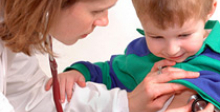Internal mini form
Contact Us Today
An initial Cerebral Palsy diagnosis requires screens, tests and evaluations. However, the process of assessing a child’s condition does not end upon diagnosis. Many other tests and assessments are required in order to plan for and manage a child’s future development. Children are assessed for therapies, surgeries, medications, and more. In school they are evaluated for special education services and supports. Other evaluations will determine government assistance. Learn about the many evaluations that will help develop a plan of care.
About evaluations
During the diagnosis stage and immediately following a formal diagnosis, the child’s primary care physician, likely his or her pediatrician, will refer the child to any number of medical specialists in order to ascertain the extent, location and severity of the child’s condition. It is recommended that children are also tested for associative conditions that often exist alongside Cerebral Palsy. These can include seizure activity, cognitive impairment, vision impairment and hearing impairment.
The child will likely see a neurologist for the brain injury, and an orthopedic surgeon for the extent of physical impairment.
Treatment for Cerebral Palsy depends upon the severity. Likely, the child will require a multi-disciplinary team of medical experts to coordinate management of his or her health conditions. Ability evaluations are central in determining the child’s treatment plan. Therapy, assistive technology, medications, complementary medicines and surgery are commonly prescribed to those with Cerebral Palsy.
Beyond medical assessment, the public school system evaluates children through a process called the Independent Education Program, or IEP, process. The process was designed by government representatives in order to establish criteria to uniformly evaluate abilities and identify areas where additional assistance may be required.
Evaluations for IEPs include assessing activities of daily living. These are activities an individual performs in the course of a normal day for self care and independence, including personal hygiene, feeding, toileting, dressing, cleaning and transportation.
The IEP will also assess family dynamics. A family’s access to health care, insurance, income, transportation and nutrition is valuable; the ability to provide care, sustenance and shelter plays a role in management of the child’s condition.
Further, the IEP will assess the child’s learning capacity by assessing his or her health status, mobility and communication skills. The focus on the education assessment is to identify barriers to the child’s ability to learn and develop. Vision, hearing, intelligence, and performance is evaluated in an attempt to identify areas where therapists and counselors can help the child, and learning opportunities, adaptive equipment or supportive interventions can be employed.
If the child is young enough, he or she may be considered for early education programs.
The child’s parent, medical team and education team will work together to form goals that when met will maximize the child’s academic and physical performance while minimizing barriers.
The evaluation process
Upon diagnosis, an orthopedic surgeon will likely define the extent, location and severity of the child’s motor impairment. The child’s primary care physician will document any associative conditions or co-mitigating factors. Some associative conditions and co-mitigating factors may develop over the child’s lifespan and can be added to this plan. A child with special needs is urged to begin early intervention.
During early intervention and school evaluations the child’s activities of daily living will be evaluated for services and adaptive device consideration. Family dynamics and socio-economic status will be assessed by school, government agencies or specialists to assist with services and possible funding and support. Educational plans will be made during the child’s school years in the Individualized Education Plan, or IEP, process.
Evaluation includes:
Mobility/Motor Impairment Evaluation
- Abnormal muscle tone
- Movement coordination and control difficulties
- Reflex irregularity
- Abnormal posture
- Abnormal balance
- Gross motor dysfunction
- Fine motor dysfunction
- Oral motor dysfunction (Feeding, swallowing, respiratory, speech and vocal)
To learn more visit Mobility.
Associative Conditions and Co-Mitigating Factors Assessment
- Behavior
- Cognition
- Communication
- Developmental Delay
- Digestive Health
- Dysphagia
- Hearing
- Mobility
- Neurologic Health
- Nutrition Health
- Oral Health
- Orthopedic Health
- Respiratory Health
- Seizure Control
- Sensory
- Skin Health
- Socialization
- Vision
To learn more about associative conditions and co-mitigating factors, visit Associative Conditions.
Activities of Daily Living Evaluation
- Bathing
- Dressing and undressing
- Eating
- Food preparation
- Grooming
- Housekeeping
- Leisure
- Mobility
- Personal hygiene
- Recreation
- Self-care
- Shopping
- Transferring (bed, chair, toiletry, etc)
- Walking
- Work
Family Dynamics and Socio-Economic Status Assessment
- Access to health care
- Access to health insurance
- Socio-economic situation (financial, educational, parental status, language barriers)
- Caretaking capacity
- Support network
- Housing situation
- Transportation situation
- Extenuating circumstances
To learn more about care at home, visit Home-Based Assistance.
Education Assessments
- Academic Performance
- Adaptive Delay or Impairment
- Capacity to Learn/Learning Impairments
- Communication Level
- Emotional Status
- Health
- Intelligence
- Motor Abilities
- Social Ability
- Vision and Hearing
To learn more about evaluation, visit Education Assessments.

Care Plan
Many individuals come to the aid of a family touched by Cerebral Palsy. Since every child’s condition and circumstances are unique, their needs will be, as well. The types of services a family can afford or need, and the level of support they receive depends upon many factors. Access to health care facilities, health insurance, adequate shelter, financial stability, government assistance, community support, effective education plans, and funding can be extremely beneficial. The care plan outlines various aspects a parent may want to explore while managing their child’s journey with Cerebral Palsy. Care Plan








